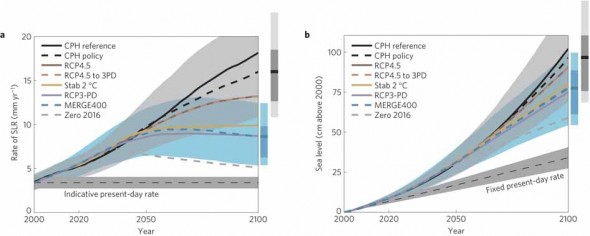Sea levels around the world can be expected to rise by several metres in coming centuries, if global warming carries on. Even if global warming is limited to 2 degrees Celsius, global-mean sea level could continue to rise, reaching between 1.5 and 4 metres above present-day levels by the year 2300, with the best estimate being at 2.7 metres, according to a study just published in Nature Climate Change.
That is the take-home from a new paper in Nature Climate Change (Shcaeffer et al. 2012) “Long-term sea-level rise implied by 1.5?°C and 2?°C warming levels”
The paper is based on the known positive relationship between global temperature and sea level. The team calibrated this relationship with data from North Carolina salt marshes, which leave an excellent record of sea level.
While the findings suggest that even at relatively low levels of global warming the world will have to face significant sea-level rise, the study also demonstrates the benefits of reducing greenhouse-gas emissions. Limiting global warming to below 1.5 degrees Celsius and subsequent temperature reductions could halve sea-level rise by 2300, compared to a 2-degree scenario. If temperatures are allowed to rise by 3 degrees, the expected sea-level rise could range between 2 and 5 metres, with the best estimate being at 3.5 metres.
The potential impacts are significant. “As an example, for New York City it has been shown that one meter of sea level rise could raise the frequency of severe flooding from once per century to once every three years,” says Stefan Rahmstorf of the Potsdam Institute for Climate Impact Research, co-author of the study. Also, low lying deltaic countries like Bangladesh and many small island states are likely to be severely affected.
Figure 2: SLR over the twenty-first century. a, Rate of SLR and b, SLR projections 2000–2100. Error bars on the right-hand side show 90% uncertainty range, resulting from the full set of parameter values used in the semi-empirical SLR equations combined with median temperature projections (dark shaded) and the wider uncertainty resulting from including the full range of temperature projections as well (light shaded). Uncertainty ranges are shown for only two scenarios for reasons of readability, focusing on the mitigation scenarios that reach the lowest and highest rates of SLR by 2100. Lines indicate median estimates. The indicative/fixed present-day rate of 3.3?mm?yr?1 is the satellite-based mean rate 1993–2007 (ref. 23).
Leave a Reply to galapagos travel Cancel reply